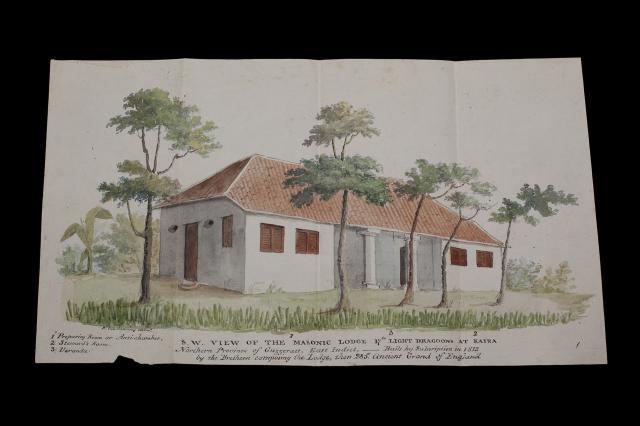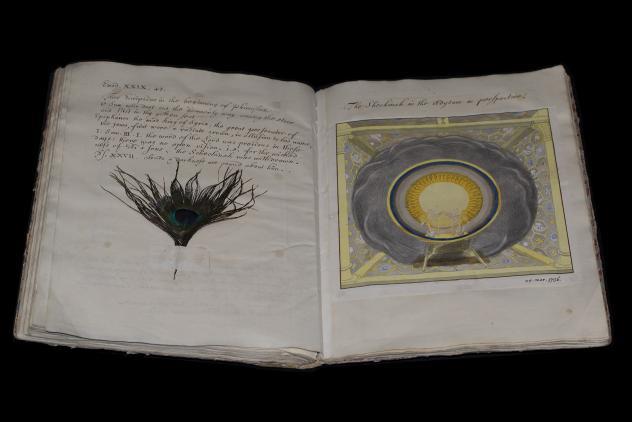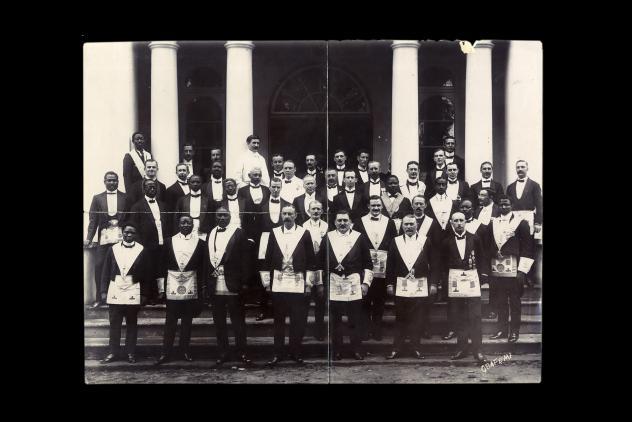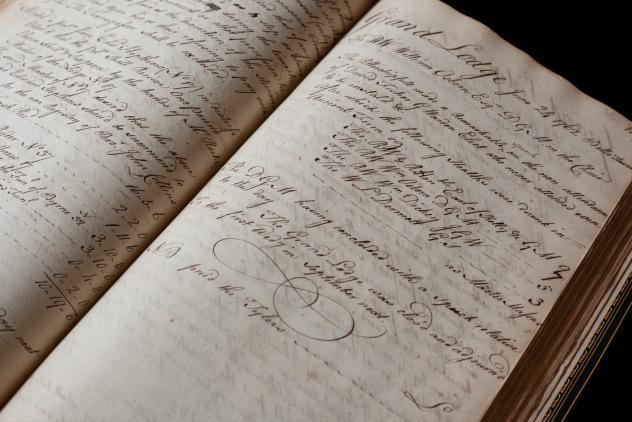These wonderful watercolours were discovered by chance when I was on a quest to find some information while cataloguing an account book and minute books from an erased lodge (a lodge no longer meeting). The pictures include a plan, elevation and interior of a small lodge room constructed at Kaira, now Kheda, Gujarat, India. A centre of tobacco growing in recent times, Kheda is about twenty miles from the former regional capital, Ahmedabad, near the North West frontier of India.
The hand-painted watercolours were sent with annual returns of members to Grand Lodge in 1822 by the Worshipful Master of a lodge meeting under a travelling warrant based in the 17th Regiment of Light Dragoons (Lancers). Granted a warrant by the Antients’ Grand Lodge in September 1794, the lodge met at first as No. 285. Travelling around England and Ireland with the Regiment, Lodge No. 285 met at premises near Netley Church, Hampshire at formation, before relocating to India in 1808. Eventually the Lodge moved to Kaira and met as No. 361, after the union between the Antients’ and Moderns’ Grand Lodges in 1813.
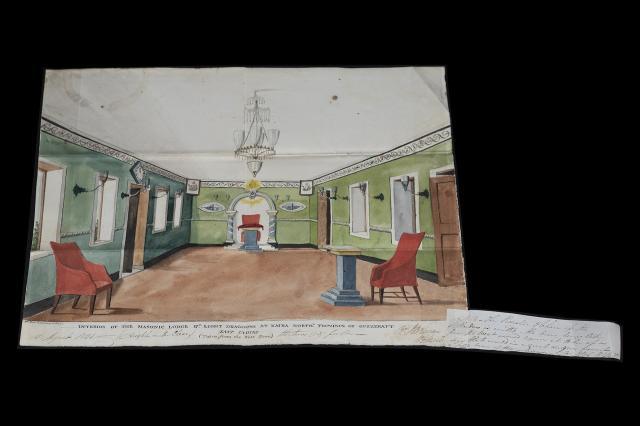
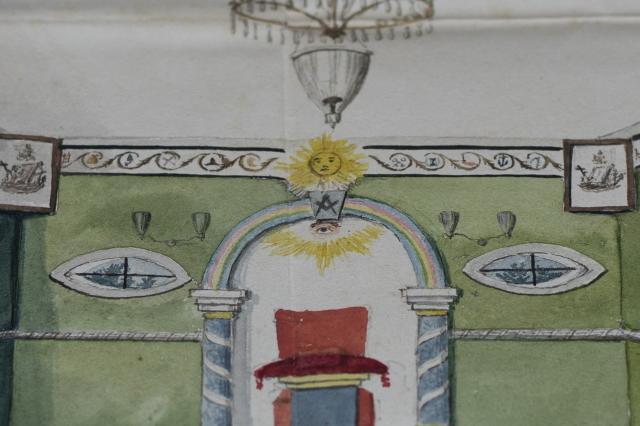
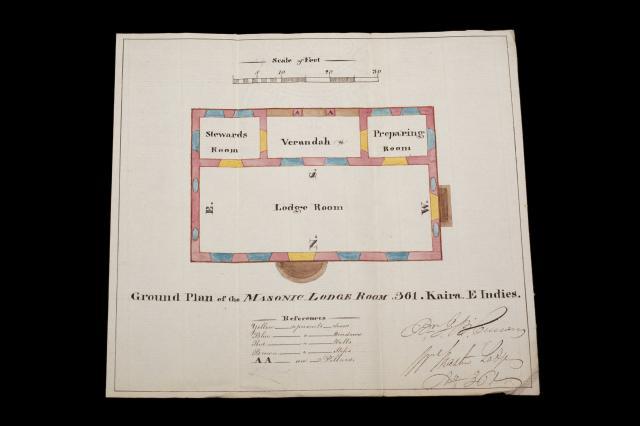
We know the Lodge experienced difficulty in meeting during the third war with the Maratha Empire from 1817 to 1818. This war consolidated control on the sub-continent by the British East India Company to form the Bombay Presidency. The Lodge minute and account books include references to support provided to widows and children of several members. In one example, Sarah, the orphaned daughter of Patrick Carberry who was killed in action in March 1817, received regular monthly sums for dresses and education.
After losing several members in this conflict, the Lodge recovered and sent our three watercolours depicting its meeting room to Grand Lodge in 1821, intended for publication in the Masonic Magazine, edited by the printer, James Asperne. The talented artist who executed the paintings was George Salisbury, a private and musician in the 17th Regiment of Light Dragoons. Salisbury, who painted a standard for the Chapter associated with the Lodge and provided some illustrated private lodge certificates, was proposed for membership by the Lodge Secretary, John Fleeson. Salisbury was initiated without charge as a serving brother in the Lodge room at Kaira, which was built by subscription in 1812. The account book includes payments for a gardener to maintain the Lodge room grounds and to remove the invasive trees, depicted in the elevation painting.
Providing the appearance of a fine Regency drawing room interior, the design of a rainbow arch above the Master’s chair may indicate the Lodge room also served for Royal Ark Mariner ceremonies. The Lodge obtained a Charter for Royal Arch ceremonies and George Salisbury was exalted in the Chapter on 30 December 1822. A private Royal Arch certificate for Chapter member John Clifford designed by Salisbury survives in the Museum collections today as you can see below.
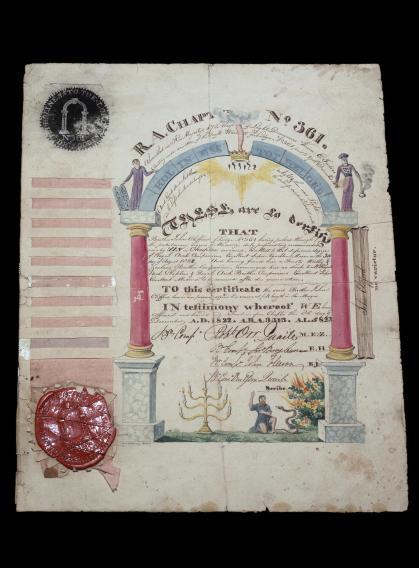
George Barnes (1782-1847) was appointed as the first Archdeacon of Bombay in 1814 and five churches were built soon afterwards at Kaira and at Surat, Thana, Poona, and Baroda. The Lodge minute book records details of a foundation stone laying ceremony for St John's Church, Kaira, on 28 February 1822, with children from the regimental school leading the procession. Lodge members wore thier regalia and carried a cornucopia, wine, salt and corn for the stone laying ceremony. The church was consecrated by Barnes' friend, Bishop Reginald Heber, during his visit to Bombay two years later. A keen hymn writer in the missionary style, Heber’s phraseology now appears insensitive to other beliefs. Gandhi, who launched a campaign at Kaira against oppressive British taxation during a famine, criticised the patronising themes of Heber’s hymn, ‘From Greenland's Icy Mountains’, in a speech in 1925.
The Lodge returned with the Regiment to England in 1823, meeting at Romford, Essex and Canterbury, Kent before 1826. It appears to have survived all subsequent peregrinations after its formation in 1794 but decided not to continue meeting after the Regiment was posted to Ireland in 1828. At this time, Robert Orr Quaile, a Lodge member for twenty seven years, retired from the army on half-pay and was unable to keep the Lodge active, given its reduced membership. Quaile and the other members decided to return the warrant which was received by Grand Lodge on 8 March 1828.
After over thirty years of meeting, the Lodge chest, including regalia, furniture and the minute and account books, was returned to Grand Lodge. The survival and discovery of these beautiful watercolours serves as a wonderful reminder for the importance of collecting such artefacts. It demonstrates in quite a poetic way how an epic story taking in the unification of the Grand Lodges, and the British Empire’s presence around the world from Ireland to India, can unfold from a previously forgotten detail.
The Kaira watercolours have featured in Treasures, an exhibition of unique items from the Library and Archives collections.
